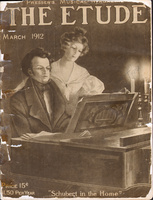The long-experienced professional finds little difficulty in tuning and keeping his instrument in proper condition, but to the student and amateur it is a momentous affair. The experienced violinist can put a string on the violin in one or two minutes by the watch, the inexperienced pupil may tinker around ten or fifteen.
The moral of this preface is, that it is absolutely the first duty of the violin teacher to show his pupils how to tune and to take care of their instruments. I have known poor teachers to succeed in building up a good business, where far better teachers failed, simply because the former attended to these very important details and the latter did not. How can a violin pupil make proper progress if he cannot tune his violin corectly? (sic) He will show very little progress at the lesson hours, if he has been practicing on a violin badly out of tune in the intervals between.
The violin teacher who expects to build up a good teaching business must be practical. He must do like the manufacturers of the safety razors—make things easy for his patrons. This the average violin teacher does not do. He tunes the pupil’s violin himself when the lesson commences instead of having the pupil do it himself under the teacher’s direction, and may make a few vague suggestions at rare intervals about the care of the instrument. Since there is no class of instruments in which so much is required of the performer in the way of tuning, and looking after the adjustment of the various parts, as string instruments, it naturally follows that the teacher should use extraordinary pains in instructing his pupils in these matters.
Many violin teachers will contend that, as many of their pupils come for only a single lesson a week, and that possibly but for thirty minutes, they cannot afford to devote so much of the lesson hour to these matters. They would find, however, that their pupils would make far better progress in the long run, if they would devote half or even all of the lesson period for a few lessons, to instruction in tuning and care of the violin, until the pupil has mastered it. Every pupil should be instructed to get some little text book on the violin, of which there are several, something on the type of Honeyman’s Violin and How to Master It, in which the process of tuning, care of the violin, etc., are described at length. The pupil should be instructed to study such a work as if it were a school text book, and in this way he will learn an immense number of facts about the violin which it would take a great deal of the teacher’s time to tell him.
Violin teachers would also find it an advantage to give their pupils class lessons on these subjects once in a while, in which they could instruct them how to tune, how to put on strings, and many other things so necessary to know. This would not take up much of the teacher’s time, and would be much appreciated by pupils and their parents, besides proving of the greatest practical advantage to the progress of the pupil. It is such little evidences of interest in the pupil’s welfare, on the teacher’s part, which establishes his popularity in the estimation of the community.
The teacher must see to it that the pupil knows how to tune his violin, that he keeps an extra set of strings on hand at all times, that his rosin is in good condition, and that his violin is properly strung, with strings that are comparatively new, not false, and in good condition in every way. Many pupils get in the habit of leaving their violins at home when they come for their lessons, and ask for the loan of one of the teacher’s violins for use during the lesson hour. This practice should be frowned on by the teacher, as he should see each pupil’s violin once or twice a week, to see that it is in proper condition.



